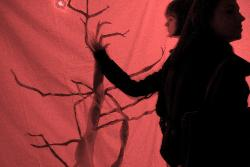 The evening of November 12th was saved from turning into an ordinary, cold autumn night by another remarkable exhibition given by the students from the Installation class. For the second time this year, they opened the doors of their studios to the curious ECLA members and allowed them to see the fusion of imagination and reality, presented through objects, light and sound.
The evening of November 12th was saved from turning into an ordinary, cold autumn night by another remarkable exhibition given by the students from the Installation class. For the second time this year, they opened the doors of their studios to the curious ECLA members and allowed them to see the fusion of imagination and reality, presented through objects, light and sound.
The showing started at 20.00 and lasted for about one and a half hours, exhibiting eight light installations. Some of them made a strong, clear point; some were subtler and, in order to be interpreted, demanded higher attention on details. The inner structure of most of the pieces revolved around the idea of self-portraits and the technique of incorporating the spectators in the piece and contradictions.
Two of the installations, in particular, stressed the idea of the “self” of the artist. In one of them, hundreds of photocopies of the artist’s face, hands and feet covered the walls, the ceiling and the floor. The studio was reduced to less than half of its original size, with sheets given the function of walls and pushing the artist on the threshold between the self and the unknown. What was beyond the self of the artist was symbolically presented on these “walls”: shadows of a bird of prey and of a bare, leafless tree, signifying our relative knowledge of everything other than ourselves. The second self portrait was more of a “translation” of the artist’s self onto an object, which, in the end, becomes an obsession. Having seen the “kater” – a Chinese souvenir cat – in restaurants, shops, streets and markets, the artist eventually came up with the idea of collecting these souvenir cats in various sizes. Then, in the installation, this collection was made even bigger, having “multiplied” the objects by using their shadows and reflections.
The technique of including the spectators and making them a part of the exhibition was employed, to varying degrees, in four of the installations. The first one had the setting of a rather peculiar gallery or a museum, where the pictures are exhibited in darkness, except for one or two. These, however, seemed to have “a mind of their own” – as soon as someone would try to see them, the light would go off. Being left for a moment in complete darkness, the next thing that one saw was a torch, a camera and – one’s own face projected on the wall. The pictures, in fact, served as a “bait” to get to the “real” object. Another inventive interactive method was used in a piece which had its own pulse. Three sculptures were shown under pulsating light, accompanied by music with a beat corresponding to the “pulse” of the light. One could easily become a part of this installation by looking into a mirror and seeing her or his own face glowing in strong neon light. A third piece involved both the artist and the audience, as if the artist was saying: “Look, this is exactly what you are doing!” Spectators were given voyeuristic roles, entering a studio which had doors in every corner, with chairs placed in front of them, “inviting” everyone to sit and peep through the keyhole. Another element in the studio added to the whole act of taking a secret look into the “otherness”: a “female” beamer on a tripod projected a “male” version of itself on the wall. An inverted house in one of the corners of the studio was another curious element. The fourth piece embraced the spectators in a more delicate way: by showing them a reflection of their soul. This was brought about by reading into Plato’s theory of the structure of the soul and converting it to an exhibition including dance and lights in three different colours. The movements of the dancer were captured by putting the lights at different angles, thus producing three different shadows of that movement. All of this served the purpose of showing the Platonic soul and the three different parts of it, as the artist herself explained.
In two of the pieces the notion of opposition was applied to bring out the artists’ ideas. One of them had a very straight-forward, powerful approach and had sculptures of the two most contrasting words: “yes” and “no”. The light shifted between these two words, guiding a puzzled voice, who, eventually said: “I don’t know…”
The second piece was structured around the polarity of the natural and the artificial life. The visual effect was quite ambiguous. One way of seeing it was to interpret it as a garden, a symbol of fertility. However, if the lights and the form of the “fruits” were taken into account, this could also be seen as a laboratory, a place where life is artificially conceived.
This exhibit proved again that it is possible to extend the limit of reality and to achieve what at moments seems to be unattainable. Strong dedication to art will always be something that enriches the ECLA experience.
By Elena Volkanovska (’09, Macedonia)
